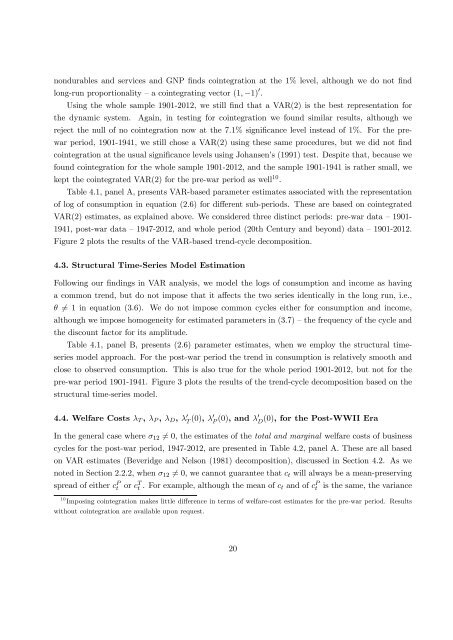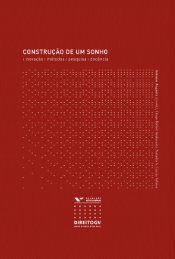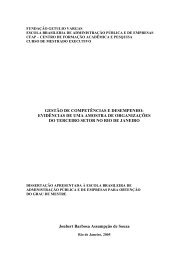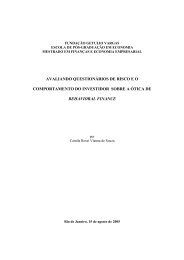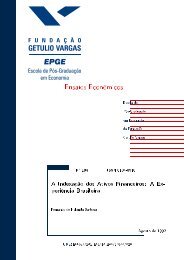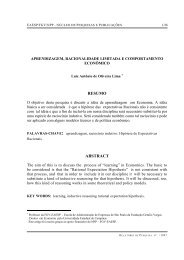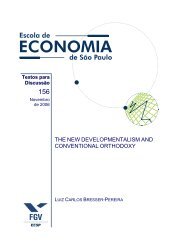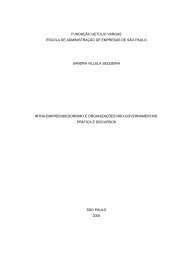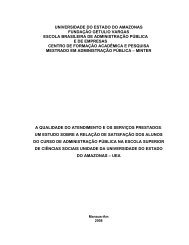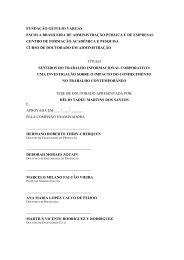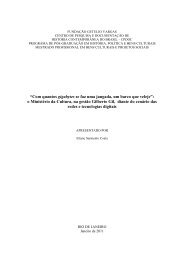Ensaios Econômicos - Sistema de Bibliotecas da FGV - Fundação ...
Ensaios Econômicos - Sistema de Bibliotecas da FGV - Fundação ...
Ensaios Econômicos - Sistema de Bibliotecas da FGV - Fundação ...
You also want an ePaper? Increase the reach of your titles
YUMPU automatically turns print PDFs into web optimized ePapers that Google loves.
nondurables and services and GNP …nds cointegration at the 1% level, although we do not …nd<br />
long-run proportionality –a cointegrating vector (1; 1) 0 .<br />
Using the whole sample 1901-2012, we still …nd that a VAR(2) is the best representation for<br />
the dynamic system. Again, in testing for cointegration we found similar results, although we<br />
reject the null of no cointegration now at the 7.1% signi…cance level instead of 1%. For the prewar<br />
period, 1901-1941, we still chose a VAR(2) using these same procedures, but we did not …nd<br />
cointegration at the usual signi…cance levels using Johansen’s (1991) test. Despite that, because we<br />
found cointegration for the whole sample 1901-2012, and the sample 1901-1941 is rather small, we<br />
kept the cointegrated VAR(2) for the pre-war period as well 10 .<br />
Table 4.1, panel A, presents VAR-based parameter estimates associated with the representation<br />
of log of consumption in equation (2.6) for di¤erent sub-periods. These are based on cointegrated<br />
VAR(2) estimates, as explained above. We consi<strong>de</strong>red three distinct periods: pre-war <strong>da</strong>ta –1901-<br />
1941, post-war <strong>da</strong>ta –1947-2012, and whole period (20th Century and beyond) <strong>da</strong>ta –1901-2012.<br />
Figure 2 plots the results of the VAR-based trend-cycle <strong>de</strong>composition.<br />
4.3. Structural Time-Series Mo<strong>de</strong>l Estimation<br />
Following our …ndings in VAR analysis, we mo<strong>de</strong>l the logs of consumption and income as having<br />
a common trend, but do not impose that it a¤ects the two series i<strong>de</strong>ntically in the long run, i.e.,<br />
6= 1 in equation (3.6). We do not impose common cycles either for consumption and income,<br />
although we impose homogeneity for estimated parameters in (3.7) –the frequency of the cycle and<br />
the discount factor for its amplitu<strong>de</strong>.<br />
Table 4.1, panel B, presents (2.6) parameter estimates, when we employ the structural timeseries<br />
mo<strong>de</strong>l approach. For the post-war period the trend in consumption is relatively smooth and<br />
close to observed consumption. This is also true for the whole period 1901-2012, but not for the<br />
pre-war period 1901-1941. Figure 3 plots the results of the trend-cycle <strong>de</strong>composition based on the<br />
structural time-series mo<strong>de</strong>l.<br />
4.4. Welfare Costs T , P , D , 0 T (0), 0 P (0), and 0 D<br />
(0), for the Post-WWII Era<br />
In the general case where 12 6= 0, the estimates of the total and marginal welfare costs of business<br />
cycles for the post-war period, 1947-2012, are presented in Table 4.2, panel A. These are all based<br />
on VAR estimates (Beveridge and Nelson (1981) <strong>de</strong>composition), discussed in Section 4.2. As we<br />
noted in Section 2.2.2, when 12 6= 0, we cannot guarantee that c t will always be a mean-preserving<br />
spread of either c P t or c T t . For example, although the mean of c t and of c P t is the same, the variance<br />
10 Imposing cointegration makes little di¤erence in terms of welfare-cost estimates for the pre-war period. Results<br />
without cointegration are available upon request.<br />
20


